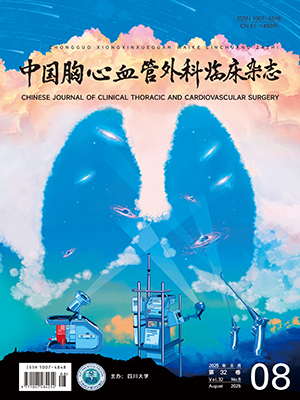| 1. |
Ell C, May A, Pech O, et al. Curative endoscopic resection of early esophageal adenocarcinomas (Barrett's cancer). Gastrointest Endosc, 2007, 65(1): 3-10.
|
| 2. |
Mönig S, Chevallay M, Niclauss N, et al. Early esophageal cancer: the significance of surgery, endoscopy, and chemoradiation. Ann N Y Acad Sci, 2018, 1434(1): 115-123.
|
| 3. |
Emi M, Hihara J, Hamai Y, et al. Clinicopathologic features of submucosal esophageal squamous cell carcinoma. Ann Thorac Surg, 2017, 104(6): 1858-1864.
|
| 4. |
Zhou Y, Du J, Li H, et al. Clinicopathologic analysis of lymph node status in superficial esophageal squamous carcinoma. World J Surg Oncol, 2016, 14(1): 259.
|
| 5. |
Molena D, Schlottmann F, Boys JA, et al. Esophagectomy following endoscopic resection of submucosal esophageal cancer: a highly curative procedure even with nodal metastases. J Gastrointest Surg, 2017, 21(1): 62-67.
|
| 6. |
Goseki N, Koike M, Yoshida M. Histopathologic characteristics of early stage esophageal carcinoma. A comparative study with gastric carcinoma. Cancer, 1992, 69(5): 1088-1093.
|
| 7. |
Ando N, Ozawa S, Kitagawa Y, et al. Improvement in the results of surgical treatment of advanced squamous esophageal carcinoma during 15 consecutive years. Ann Surg, 2000, 232(2): 225-232.
|
| 8. |
Park SY, Kim DJ, Son T, et al. Extent of mediastinal lymphadenectomy and survival in superficial esophageal squamous cell carcinoma. J Gastrointest Surg, 2017, 21(10): 1584-1590.
|
| 9. |
Kajiyama Y, Iwanuma Y, Tomita N, et al. Size analysis of lymph node metastasis in esophageal cancer: diameter distribution and assessment of accuracy of preoperative diagnosis. Esophagus, 2006, 3(4): 189-195.
|
| 10. |
Park SY, Kim DJ, Jung HS, et al. Relationship between the size of metastatic lymph nodes and positron emission tomographic/computer tomographic findings in patients with esophageal squamous cell carcinoma. World J Surg, 2015, 39(12): 2948-2954.
|
| 11. |
Shen W, Shen Y, Tan L, et al. A nomogram for predicting lymph node metastasis in surgically resected T1 esophageal squamous cell carcinoma. J Thorac Dis, 2018, 10(7): 4178-4185.
|
| 12. |
Yajin S, Murakami G, Takeuchi H, et al. The normal configuration and interindividual differences in intramural lymphatic vessels of the esophagus. J Thorac Cardiovasc Surg, 2009, 137(6): 1406-1414.
|
| 13. |
Tomita N, Matsumoto T, Hayashi T, et al. Lymphatic invasion according to D2-40 immunostaining is a strong predictor of nodal metastasis in superficial squamous cell carcinoma of the esophagus: algorithm for risk of nodal metastasis based on lymphatic invasion. Pathol Int, 2008, 58(5): 282-287.
|
| 14. |
杨玉赏, 胡伟鹏, 陈龙奇. 脉管癌栓对食管鳞状细胞癌预后的影响. 中华胸心血管外科杂志, 2015, 31(11): 656-659.
|
| 15. |
李苗, 曾晓清, 谭黎杰, 等. 浅表食管癌术后患者的生存及预后分析. 中华医学杂志, 2016, 96(6): 460-463.
|
| 16. |
Li B, Chen H, Xiang J, et al. Prevalence of lymph node metastases in superficial esophageal squamous cell carcinoma. J Thorac Cardiovasc Surg, 2013, 146(5): 1198-1203.
|
| 17. |
Pennathur A, Farkas A, Krasinskas AM, et al. Esophagectomy for T1 esophageal cancer: outcomes in 100 patients and implications for endoscopic therapy. Ann Thorac Surg, 2009, 87(4): 1048-1054.
|
| 18. |
Hölscher AH, Bollschweiler E, Schröder W, et al. Prognostic impact of upper, middle, and lower third mucosal or submucosal infiltration in early esophageal cancer. Ann Surg, 2011, 254(5): 802-807.
|
| 19. |
Tanaka T, Matono S, Nagano T, et al. Esophagectomy with extended lymphadenectomy for submucosal esophageal cancer: long-term outcomes and prognostic factors. Ann Surg Oncol, 2012, 19(3): 750-756.
|
| 20. |
Kato H, Tachimori Y, Watanabe H, et al. Superficial esophageal carcinoma. Surgical treatment and the results. Cancer, 1990, 66(11): 2319-2323.
|
| 21. |
Nabeya K, Nakata Y. Extent of resection and lymphadenectomy in early squamous cell esophageal cancer. Dis Esophagus, 1997, 10(3): 159-161.
|




